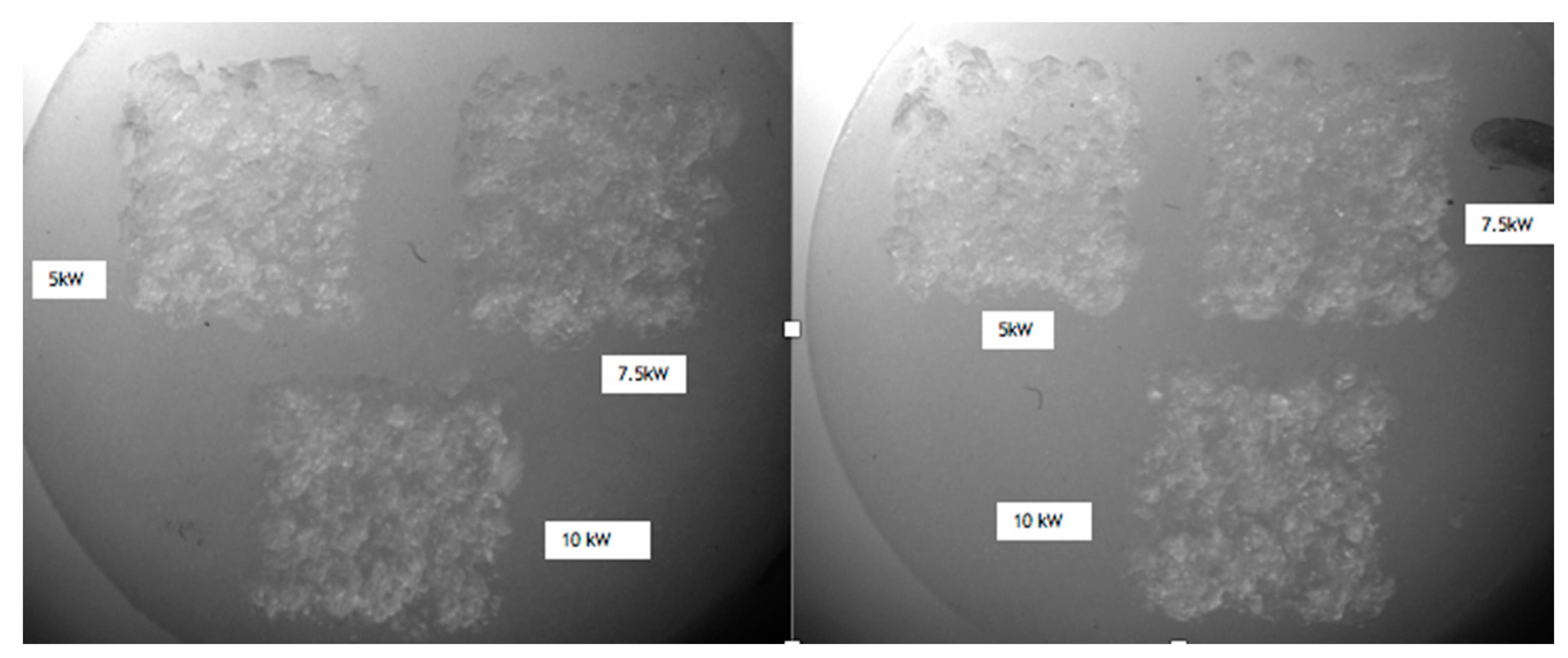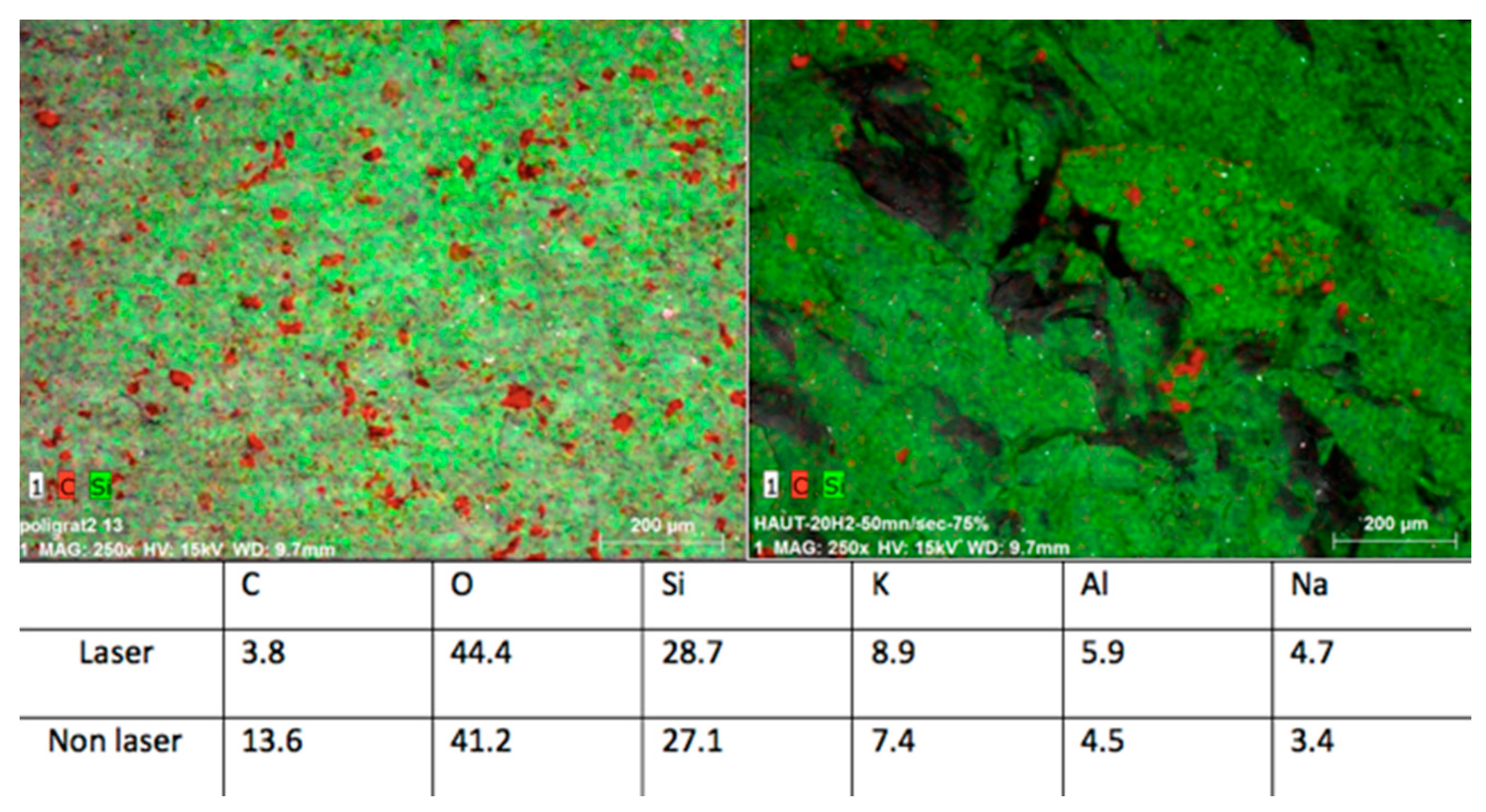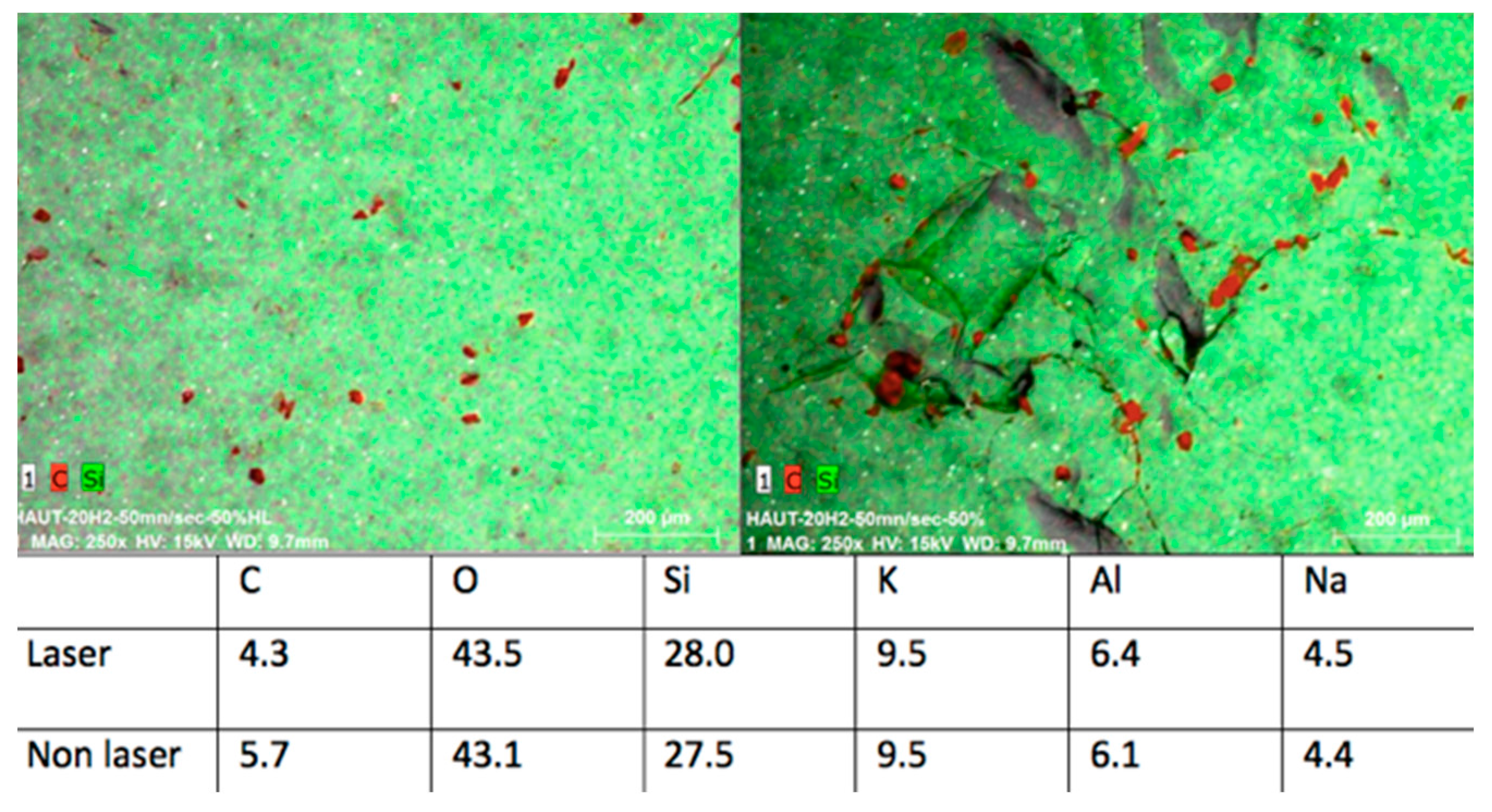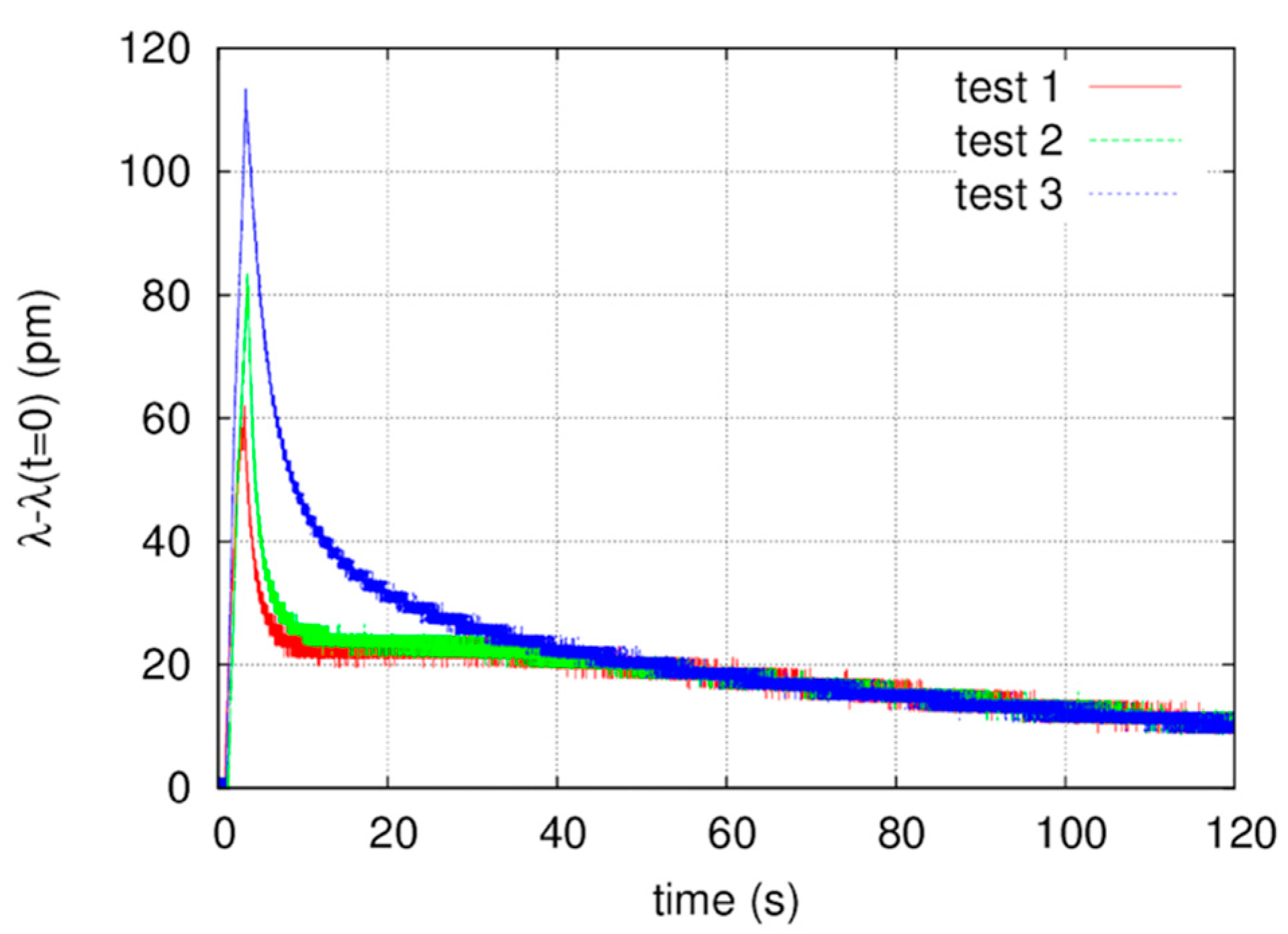Disilicate Dental Ceramic Surface Preparation by 1070 nm Fiber Laser: Thermal and Ultrastructural Analysis
Abstract
:1. Introduction
2. Materials and Methods
3. Results
3.1. SEM Observation
3.2. EDS Analysis
3.3. Thermal Analysis
4. Discussion
5. Conclusions
Acknowledgments
Author Contributions
Conflicts of Interest
References
- Cheung, G.S. A preliminary investigation into the longevity and causes of failure of single unit extracoronal restorations. J. Dent. 1991, 19, 160–163. [Google Scholar] [CrossRef]
- Ulusoy, M.; Toksavul, S. Fracture resistance of five different metal framework designs for metal-ceramic restorations. Int. J. Prosthodont. 2002, 15, 571–574. [Google Scholar] [PubMed]
- Kang, M.S.; Ercoli, C.; Galindo, D.F.; Graser, G.N.; Moss, M.E.; Tallents, R.H. Comparison of the load at failure of soldered and non-soldered porcelain-fused-to-metal crowns. J. Prosthet. Dent. 2003, 90, 235–240. [Google Scholar] [CrossRef]
- Michalakis, K.X.; Stratos, A.; Hirayama, H.; Kang, K.; Touloumi, F.; Oishi, Y. Fracture resistance of metal ceramic restorations with two different margin designs after exposure to masticatory simulation. J. Prosthet. Dent. 2009, 102, 172–178. [Google Scholar] [CrossRef]
- Appeldoom, R.E.; Wilwerding, T.M.; Barkmeier, W.W. Bond strength of composite resin to porcelain with newer generation porcelain repair systems. J. Prosthet. Dent. 1993, 70, 6–11. [Google Scholar] [CrossRef]
- Demirel, F.; Muhtarogullari, M.; Yuksel, G.; Cekiç, C. Microleakage study of 3 porcelain repair materials by autoradiography. Quintessence Int. 2007, 38, 285–290. [Google Scholar]
- Giordano, R.; McLaren, E.A. Ceramics overview: Classification by microstructure and processing methods. Compend. Contin. Educ. Dent. 2010, 31, 682–684. [Google Scholar] [PubMed]
- Albakry, M.; Guazzato, M.; Swain, M.V. Fracture toughness and hardness evaluation of three pressable all-ceramic dental materials. J. Dent. 2003, 31, 181–188. [Google Scholar] [CrossRef]
- Chung, K.H.; Hwang, Y.C. Bonding strengths of porcelain repair systems with various surface treatments. J. Prosthet. Dent. 1997, 78, 267–274. [Google Scholar] [CrossRef]
- Suliman, A.H.; Swift, E.J., Jr.; Perdigao, J. Effects of surface treatment and bonding agents on bond strength of composite resin to porcelain. J. Prosthet. Dent. 1993, 70, 118–120. [Google Scholar] [CrossRef]
- Diaz-Arnold, A.M.; Schneider, R.L.; Aquilino, S.A. Bond strengths of intraoral porcelain repair materials. J. Prosthet. Dent. 1989, 61, 305–309. [Google Scholar] [CrossRef]
- Holand, W.; Schweiger, M.; Frank, M.; Rheinberger, V. A comparison of the microstructure and properties of the IPS empress 2 and the IPS empress glass ceramics. J. Biomed. Mater. Res. 2000, 53, 297–303. [Google Scholar] [CrossRef]
- Della Bona, A.; Mecholsky, J.J., Jr.; Anusavice, K.J. Fracture behavior of lithia disilicate and leucite based ceramics. Dent. Mater. 2004, 20, 956–962. [Google Scholar] [CrossRef] [PubMed]
- Piwowarczyk, A.; Ottl, P.; Lauer, H.C.; Kuretzky, T. A clinical report and overview of scientific studies and clinical procedures conducted on the 3 M ESPE lava all-ceramic system. J. Prosthodont. 2005, 14, 39–45. [Google Scholar] [CrossRef] [PubMed]
- Tuchin, V. Dictionary of Biomedical Optics and Biophotonics; SPIE Press: Bellingham, WA, USA, 2012; pp. 394–397. ISBN 0819489735. [Google Scholar]
- Pierce, M.; Jackson, S.; Golding, P.; Dickinson, B.; Dickinson, M.; King, T.; Sloan, P. Development and application of fiber lasers for medical applications. In Proceedings of the 2001 International Symposium on Biomedical Optics, San Jose, CA, USA, 20–26 January 2001; SPIE Press: Bellingham, WA, USA, 2001. [Google Scholar]
- Shiner, B. The impact of fiber laser technology on the world wide material processing market. In Proceedings of the CLEO: Applications and Technology 2013, San Jose, CA, USA, 9–14 June 2013; Optical Society of America: Washington, DC, USA, 2013. [Google Scholar]
- Zheng, C.; Zhang, H.; Yan, P.; Gong, M. Low repetition rate broadband high energy and peak power nanosecond pulsed Yb-doped fiber amplifier. Opt. Laser Technol. 2013, 49, 284–287. [Google Scholar] [CrossRef]
- Stutzki, F.; Jansen, F.; Liem, A.; Jauregui, C.; Limpert, J.; Tünnermann, A. 26 mJ, 130 W Q-switched fiber-laser system with near-diffraction-limited beam quality. Opt. Lett. 2012, 37, 1073–1075. [Google Scholar] [CrossRef] [PubMed]
- Thompson, J.Y.; Stoner, B.R.; Piascik, J.R.; Smith, R. Adhesion/cementation to zirconia and other non-silicate ceramics: Where are we now? Dent. Mater. 2011, 27, 71–82. [Google Scholar] [CrossRef] [PubMed]
- Filho, A.M.; Vieira, L.C.; Araujo, E.; Monteiro Junior, S. Effect of different ceramic surface treatments on resin microtensile bond strength. J. Prosthodont. 2004, 13, 28–35. [Google Scholar] [CrossRef] [PubMed]
- Della Bona, A.; Borba, M.; Benetti, P.; Pecho, O.E.; Alessandretti, R.; Mosele, J.C.; Mores, R.T. Adhesion to Dental Ceramics. Curr. Oral Health Rep. 2014, 1, 232–238. [Google Scholar] [CrossRef]
- Saracoglu, A.; Cura, C.; Cotert, H.S. Effect of various surface treatment methods on the bond strength of the heat-pressed ceramic samples. J. Oral Rehabil. 2004, 31, 790–797. [Google Scholar] [CrossRef] [PubMed]
- Blatz, M.B.; Sadan, A.; Kern, M. Resin-ceramic bonding-A review of the literature. J. Prosthet. Dent. 2003, 89, 268–274. [Google Scholar] [CrossRef] [PubMed]
- Rocca, J.-P.; Fornaini, C.; Brulat-Bouchard, N.; Bassel Seif, S.; Darque-Ceretti, E. CO2 and Nd:YAP laser interaction with lithium disilicate and Zirconia dental ceramics: A preliminary study. Opt. Laser Technol. 2014, 57, 216–223. [Google Scholar] [CrossRef]
- El Gamal, A.; Fornaini, C.; Rocca, J.P.; Muhammad, O.H.; Medioni, E.; Cucinotta, A.; Brulat-Bouchard, N. The effect of CO2 and Nd:YAP lasers on CAD/CAM Ceramics: SEM, EDS and thermal studies. Laser Ther. 2016, 25, 27–34. [Google Scholar] [CrossRef] [PubMed]
- Liu, L.; Liu, S.; Song, X.; Zhu, Q.; Zhang, W. Effect of Nd: YAG laser irradiation on surface properties and bond strength of zirconia ceramics. Lasers Med. Sci. 2015, 30, 627–634. [Google Scholar] [CrossRef] [PubMed]
- Ural, C.; KalyoncuoGlu, E.; Balkaya, V. The effect of different outputs of carbon dioxide laser on bonding between zirconia ceramic surface and resin cement. Acta Odontol. Scand. 2012, 70, 541–546. [Google Scholar] [CrossRef] [PubMed]
- Sadeghi, M.; Davari, A.; Abolghasami Mahani, A.; Hakimi, H. Influence of different power outputs of Er:YAG laser on shear bond strength of a resin composite to feldspathic porcelain. J. Dent. 2015, 16, 30–36. [Google Scholar]
- Shiu, P.; De Souza Zaroni, W.C.; Eduardo Cde, P.; Youssef, M.N. Effect of feldspathic ceramic surface treatments on bond strength to resin cement. Photomed. Laser Surg. 2007, 25, 291–296. [Google Scholar] [CrossRef] [PubMed]
- Erdur, E.A.; Basciftci, F.A. Effect of Ti:Sapphire-femtosecond laser on the surface roughness of ceramics. Lasers Surg. Med. 2015, 47, 833–838. [Google Scholar] [CrossRef] [PubMed]
- Li, R.; Ruckle, D.; Keheila, M.; Maldonado, J.; Lightfoot, M.; Alsyouf, M.; Yeo, A.; Abourbih, S.R.; Olgin, G.; Arenas, J.L.; et al. High-frequency dusting versus conventional holmium laser lithotripsy for intrarenal and ureteral calculi. J. Endourol. 2017, 31, 272–277. [Google Scholar] [CrossRef] [PubMed]
- Park, J.A.; Park, S.W.; Chang, I.S.; Hwang, J.J.; Lee, S.A.; Kim, J.S.; Chee, H.K.; Yun, I.J. The 1470-nm bare-fiber diode laser ablation of the great saphenous vein and small saphenous vein at 1-year follow-up using 8–12 W and a mean linear endovenous energy density of 72 J/cm. J. Vasc. Interv. Radiol. 2014, 25, 1795–1800. [Google Scholar] [CrossRef] [PubMed]
- Wu, D.C.; Friedmann, D.P.; Fabi, S.G.; Goldman, M.P.; Fitzpatrick, R.E. Comparison of intense pulsed light with 1927-nm fractionated thulium fiber laser for the rejuvenation of the chest. Dermatol. Surg. 2014, 40, 129–133. [Google Scholar] [CrossRef] [PubMed]
- Wattanakrai, P.; Pootongkam, S.; Rojhirunsakool, S. Periorbital rejuvenation with fractional 1550-nm ytterbium/erbium fiber laser and variable square pulse 2940-nm erbium:YAG laser in Asians: A comparison study. Dermatol. Surg. 2012, 38, 610–622. [Google Scholar] [CrossRef] [PubMed]
- Morin, F.; Druon, F.; Hanna, M.; Georges, P. MicroJoule femtosecond fiber laser at 1.6 μm for corneal surgery applications. Opt. Lett. 2009, 34, 1991–1993. [Google Scholar] [CrossRef] [PubMed]
- Fornaini, C.; Merigo, E.; Poli, F.; Cavatorta, C.; Rocca, J.P.; Selleri, S.; Cucinotta, A. Use of 1070 nm fiber lasers in oral surgery: Preliminary ex vivo study with FBG temperature monitoring. Laser Ther. 2017, 26, 311–318. [Google Scholar] [CrossRef]
- Rihakova, L.; Chmelickova, H. Laser Micromachining of Glass, Silicon, and Ceramics. Adv. Mater. Sci. Eng. 2015, 2015. [Google Scholar] [CrossRef]
- Vechiato Filho, A.J.; dos Santos, D.M.; Goiato, M.C.; de Medeiros, R.A.; Moreno, A.; Bonatto Lda, R.; Rangel, E.C. Surface characterization of lithium disilicate ceramic after nonthermal plasma treatment. J. Prosthet. Dent. 2014, 112, 1156–1163. [Google Scholar] [CrossRef] [PubMed]











© 2018 by the authors. Licensee MDPI, Basel, Switzerland. This article is an open access article distributed under the terms and conditions of the Creative Commons Attribution (CC BY) license (http://creativecommons.org/licenses/by/4.0/).
Share and Cite
Fornaini, C.; Poli, F.; Merigo, E.; Brulat-Bouchard, N.; El Gamal, A.; Rocca, J.-P.; Selleri, S.; Cucinotta, A. Disilicate Dental Ceramic Surface Preparation by 1070 nm Fiber Laser: Thermal and Ultrastructural Analysis. Bioengineering 2018, 5, 10. https://doi.org/10.3390/bioengineering5010010
Fornaini C, Poli F, Merigo E, Brulat-Bouchard N, El Gamal A, Rocca J-P, Selleri S, Cucinotta A. Disilicate Dental Ceramic Surface Preparation by 1070 nm Fiber Laser: Thermal and Ultrastructural Analysis. Bioengineering. 2018; 5(1):10. https://doi.org/10.3390/bioengineering5010010
Chicago/Turabian StyleFornaini, Carlo, Federica Poli, Elisabetta Merigo, Nathalie Brulat-Bouchard, Ahmed El Gamal, Jean-Paul Rocca, Stefano Selleri, and Annamaria Cucinotta. 2018. "Disilicate Dental Ceramic Surface Preparation by 1070 nm Fiber Laser: Thermal and Ultrastructural Analysis" Bioengineering 5, no. 1: 10. https://doi.org/10.3390/bioengineering5010010
APA StyleFornaini, C., Poli, F., Merigo, E., Brulat-Bouchard, N., El Gamal, A., Rocca, J.-P., Selleri, S., & Cucinotta, A. (2018). Disilicate Dental Ceramic Surface Preparation by 1070 nm Fiber Laser: Thermal and Ultrastructural Analysis. Bioengineering, 5(1), 10. https://doi.org/10.3390/bioengineering5010010





